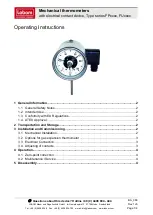
N
Power connection (Neutral) 230VAC.
O
Output. Load need to be connected between O and Neutral.
L
Power connection (Live) 230VAC.
L
Power connection (Live) 230VAC.
NTC
10K NTC Temperature sensor.
NTC
10K NTC Temperature sensor.
6. ADD/REMOVE
Please read this before installation
The primary controller/gateway has a mode for adding or removing
devices. Please refer to your primary controller manual on how to set
the primary controller in add/remove mode. The device may only be
added or removed from the network if the primary controller is in add/
remove mode.
When the device is removed from the network, it will NOT revert to
factory settings.
There are two ways to add the device to a Z-Wave network.
6.1 Method 1: Standard (Manual)
Add/remove mode is indicated on the device by a blinking green
LED. It indicated this for 90 seconds until a timeout occurs, or until the
module has been added to/removed from the network.
To start the configuration process, press the configuration button 3
times in rapid succession. The LED will light up green for 3 seconds if
adding/removing is successful.
The device is now ready for use with default settings.
NB! When the device is removed from the gateway, the parameters are
not reset. To reset the parameters, see Chapter 7 ”Factory reset”.
If inclusion fails, please perform a ”remove device” process and try
again. If inclusion fails again, please see Chapter 7 “Factory reset”.
6.2 Method 2: SmartStart (Automatic)
SmartStart enabled products may be added to a Z-Wave network
by scanning the Z-Wave QR-Code on the product if your primary
controller supports SmartStart inclusion. No further action is required
and the SmartStart product will be added automatically after being
powered on within range of the primary controller.
7. FACTORY RESET
Press and hold the configuration button. After 3 seconds the LED will start to
blink in green. After 20 seconds the LED will start to blink green rapidly for 5
seconds. You may now release the button.
NB! Please use this procedure only when the primary controller/
gateway is missing or otherwise inoperable.
8. STARTUP
After powering up the device for the first time, all the parameters will have
default settings.
9. PRINCIPLES OF REGULATION
The thermostat uses temperature readings retrieved from the sensor to
regulate heating. When you have chosen a setpoint temperature, the
thermostat will use an internal hysteresis to regulate the temperature.
10. HYSTERESIS
You can make changes to the thermostat hysteresis. You may change
the hysteresis from between 0.3°C and 3.0°C using parameter 2.
The default setting is 0.5°C. When using water-based heating, the
recommended hysteresis is 1.0°C.
11. SAFETY FEATURES
The device security features make the device safe to use and notifies the user
of any unexpected behavior in the device, such as overload or overheating.
If this happens, the thermostat turns the relay OFF and starts to blink red
and green from the LED until the error(s) have been resolved and the device
has been disconnected and reconnected from the mains. The following
temperature notifications will be sent to the gateway/controller:
• 121°C = Overheat
• 122°C = Overload
• 123°C = Sensor short
• 124°C = Sensor not connected
11.1 Overload
The device features a 16A overload protection. The overload is triggered if
there is a current draw of more than 16A. The relay allows for inrush current. If
the current is between 16-20A it waits for 2 seconds, if it is between 20-30A it
waits for 0.5 seconds and if it is above 30A it will wait for 0.2 seconds. After the
given time the device will do the following:
• Set the relay OFF
• Blink red and green
• Send a temperature report of 122°C
To clear the overload state, the connected load has to be checked and the
thermostat must be disconnected and reconnected from the mains.
11.2 Overheating
The device features an internal temperature sensor which prevents
overheating inside the device or wall.
When overheating is detected, the device will:
• Set the relay to OFF
• Blink red and green
• Send a temperature report of 121°C
To clear the overheating state, the thermostat must be allowed to cool
down and the cause of the overheating must be removed.
11.3 Sensor short circuit
The device has the ability to detect a sensor short circuit. This is to
ensure that the device regulates correctly from the sensor.
When a sensor short circuit is detected, the device will:
• Set the relay to OFF
• Blink red and green
• Send a temperature report of 123°C
To clear the sensor short circuit error the device has to be
disconnected from the mains, then the wiring and sensor needs to be
checked. When the fault is resolved the mains can be reconnected and
the device will function normally again.
N
O
L
L
N
TC
NTC
N
TC
Last
Load
L N
Configuration button
LED light in back























